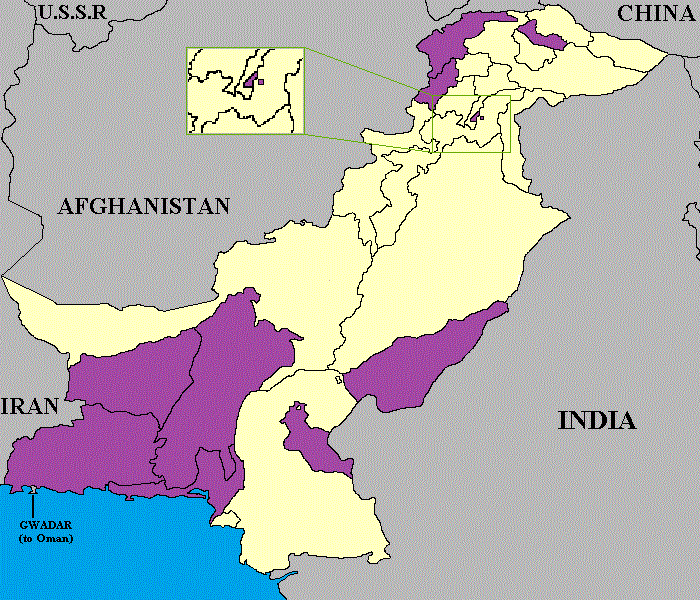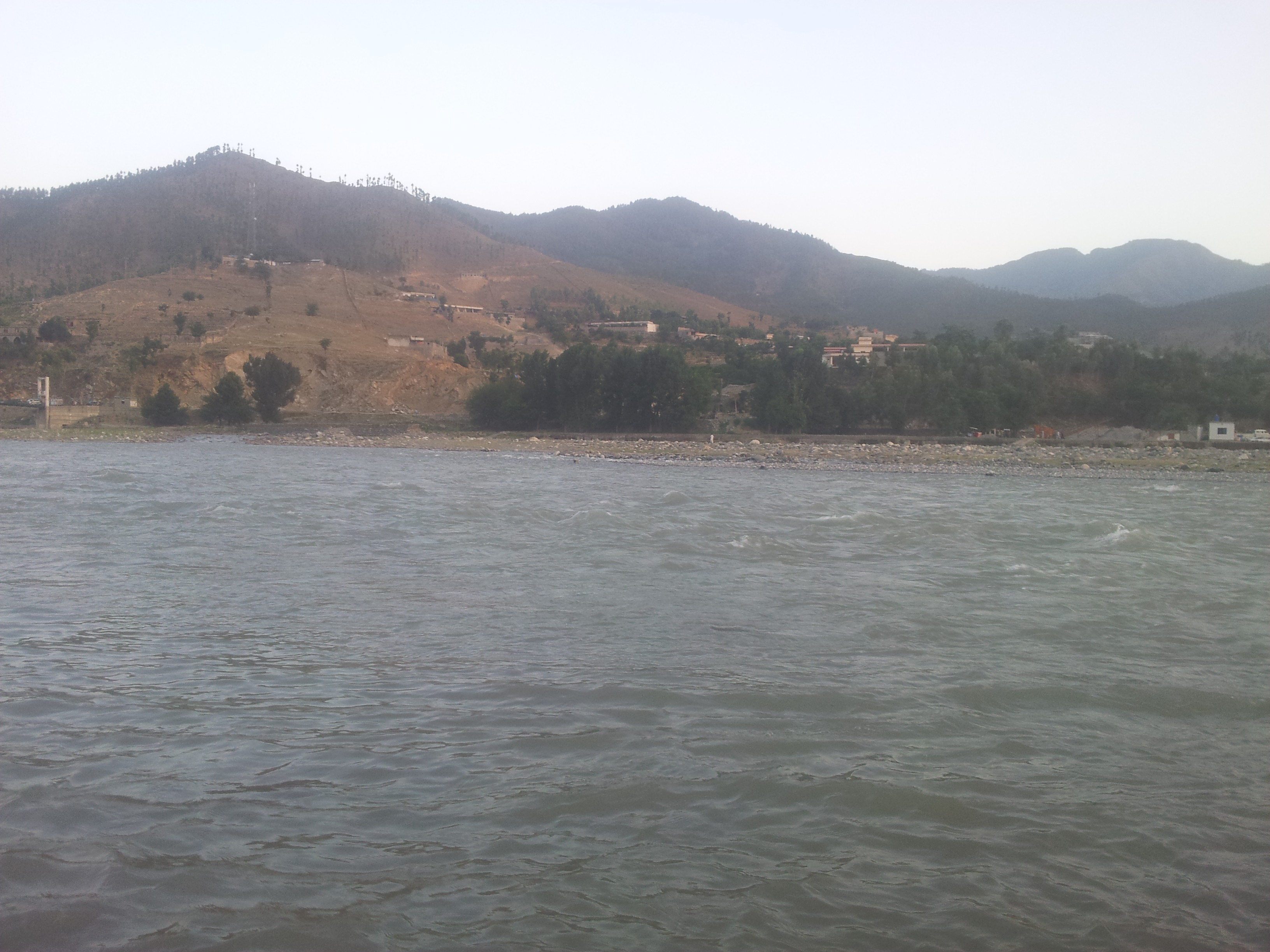|
Dir (princely State)
Dir was a princely state in a subsidiary alliance with the British Raj, located within the North-West Frontier Province. Following the Partition of British India, Dir remained independent and unaligned until February 1948, when the Dominion of Pakistan accepted its accession. The princely state ceased to exist as a distinct political entity in 1969, when it was fully incorporated into Pakistan. The territory it once covered is today located in the Pakistani province of Khyber Pakhtunkhwa, forming two northern and southern districts called Upper Dir and Lower Dir, respectively. Geography Most of the state lay in the valley of the Panjkora river, which originates in the Hindu Kush mountains and joins the Swat River near Chakdara. Apart from small areas in the south-west, Dir is a rugged, mountainous zone with peaks rising to in the north-east and to along the watersheds, with Swat to the east and Afghanistan and Chitral to the west and north. History Early period Dir ... [...More Info...] [...Related Items...] OR: [Wikipedia] [Google] [Baidu] |
Princely States Of Pakistan
The princely states of Pakistan ( ur, ; sd, پاڪستان جون نوابي رياستون) were princely states of the British Indian Empire which acceded to the new Dominion of Pakistan between 1947 and 1948, following the partition of British India and its independence. At the time of the withdrawal of British forces from the subcontinent on 15 August 1947, West Pakistan was less than half of its ultimate size. It took a year of negotiations and accidents to bring the princely states into Pakistan, and a long process of integration followed. Options of the Princes With the withdrawal of the British from the Indian subcontinent, in 1947, the Indian Independence Act provided that the hundreds of princely states which had existed alongside but outside British India were released from all their subsidiary alliances and other treaty obligations to the British, while at the same time the British withdrew from their treaty obligations to defend the states and keep the pea ... [...More Info...] [...Related Items...] OR: [Wikipedia] [Google] [Baidu] |
Swat River
The Swat River ( ur, , ps, سوات سیند) is a perennial river in the northern region of Khyber-Pakhtunkhwa Province, Pakistan. The river's source is in the high glacial valleys of the Hindu Kush mountains, where it then flows into the scenic Kalam Valley before forming the spine of the wider Swat valley – an important tourist destination in northern Pakistan for its scenic beauty, and former stronghold of the ancient Gandhara region with numerous ancient Buddhist sites scattered through the region. Name The Sanskrit name may mean "clear blue water." Another theory derives the word Swat from the Sanskrit word ''shveta'' (), also used to describe the clear water of the Swat River. To the ancient Greeks, the river was known as the ''Soastus.'' The Chinese pilgrim Faxian referred to Swat as the ''Su-ho-to''. Course The Swat's source lies in the Hindu Kush Mountains, from where it is fed by the glacial waters throughout the year. From the high valleys of Swat Kohistan, th ... [...More Info...] [...Related Items...] OR: [Wikipedia] [Google] [Baidu] |
Afghanistan
Afghanistan, officially the Islamic Emirate of Afghanistan,; prs, امارت اسلامی افغانستان is a landlocked country located at the crossroads of Central Asia and South Asia. Referred to as the Heart of Asia, it is bordered by Pakistan to the east and south, Iran to the west, Turkmenistan to the northwest, Uzbekistan to the north, Tajikistan to the northeast, and China to the northeast and east. Occupying of land, the country is predominantly mountainous with plains in the north and the southwest, which are separated by the Hindu Kush mountain range. , its population is 40.2 million (officially estimated to be 32.9 million), composed mostly of ethnic Pashtuns, Tajiks, Hazaras, and Uzbeks. Kabul is the country's largest city and serves as its capital. Human habitation in Afghanistan dates back to the Middle Paleolithic era, and the country's Geostrategy, strategic location along the historic Silk Road has led it to being described, pict ... [...More Info...] [...Related Items...] OR: [Wikipedia] [Google] [Baidu] |
Panjkora River
The Panjkora River ( ur, ) is a river in the Khyber Pakhtunkhwa province of the northwest of Pakistan. The river runs through the mountainous northern part of the province, and forms the Kumrat Valley. It passes from Dir, Timergara and meet at Chakdara with Swat river. It generally characterized by having steep slopes on either side of the riverbank covered in thick forests. The river has a large catchment area, making the river susceptible to significant flooding - most notably during the 2010 floods that occurred throughout much of Pakistan. Geography The Panjkora river is the main river in the Panjkora River Basin which is a part of the larger Swat River Basin located in the Khyber Pakhtunkhwa province in the northwest of Pakistan. Main tributaries of the Panjkora river are Rivers Dir, Barawal, Kohistan and Usherai. The flow of water occurs year-round, during the monsoon season (June-September) the water levels drastically rise. Large amounts of water can be found during ... [...More Info...] [...Related Items...] OR: [Wikipedia] [Google] [Baidu] |
Swati (Pashtun Tribe)
Swatis (Urdu: سواتی, Pashto: سواتي) are a Pashtun tribe, mostly inhabiting the Hazara Division of the Khyber Pakhtunkhwa province in Pakistan. They are mostly agricultural and are the biggest land owning tribe in the districts of Mansehra and Batagram (Feudal Tanawal excluded). Swatis are divided into four major tribal clans: Gabri (گبری), Mitravi (متراوی), Mumyaali (ممیالی) and Toar (ٹوڑ). Some of them speak Hindko in towns like Mansehra, Balakot, Naran, Kaghan and Garhi Habibullah while majority of them speak Pashto as a mother tongue. Their code of conduct and customs are similar to Pashtunwali, and are called Swatiwali. Swatis are sometimes referred to as Suwadis and Servatis. Most of them are orthodox Muslims, and have been Muslim since Ghaznavid times. They are staunch followers of the Hanafi school of Islamic jurisprudence. According to the 1911 Census Report, the tribe was counted as having 33,000 individuals in Hazara District alone, excl ... [...More Info...] [...Related Items...] OR: [Wikipedia] [Google] [Baidu] |
Jandol State
Jandol (also called Jandool or Jandul) was a minor Pashtun princely state at the time of the British Raj. It was established circa 1830, with its capital at Barwa (modern Samarbagh). Umra Khan was probably its most prominent ruler. It became a part of the princely state of Dir and later of Pakistan as a result of the integration of the princely states of Pakistan The princely states of Pakistan ( ur, ; sd, پاڪستان جون نوابي رياستون) were princely states of the British Indian Empire which acceded to the new Dominion of Pakistan between 1947 and 1948, following the partition of Br .... References Princely states of Pakistan {{KhyberPakhtunkhwa-geo-stub ... [...More Info...] [...Related Items...] OR: [Wikipedia] [Google] [Baidu] |
Dilazak
The Dilazak ( ps, دلزاک) is a Pashtun tribe, primarily living in Khyber-Pakhtunkhwa. History The Dilazak originally dwelled in eastern Afghanistan. They were among the earliest Pashtun tribes to have migrated to present-day northwestern Pakistan. The Dilazak expelled or subdued the local inhabitants of the area. According to Aain-i-Akbari (Written around 1590 CE), the Dilazak were the only Pashtun tribe that possessed lands in Hazara Qaarlugh. Around 1520, another Pashtun tribe, the Yousafzai, was expelled from Kabul by Mirza Ulugh Beg (March 22, 1394 in Sultaniyeh (Persia) – October 27, 1449 (Samarkand)), a Timurid ruler and paternal uncle of the Mughal Emperor Zahir-ud-din Muhammad Babur. The Yusufzai migrated to Peshawar valley where they sought and received help from the Dilazak. Later, the relationships between the two tribes deteriorated and a long war ensued. 20 years later, at the battle of Katlang, the Yousafzai pushed the Dilazak east of the Indus River under ... [...More Info...] [...Related Items...] OR: [Wikipedia] [Google] [Baidu] |
Sultan Khel
Sultan Khel is a village and union council of Mianwali District in the Punjab province of Pakistan. It is located in Isakhel Tehsil Isakhel Tehsil ( ur, ), is an administrative subdivision (tehsil) of Mianwali District in the Punjab province of Pakistan. The city of Isakhel is the headquarters of the tehsil which is administratively subdivided into 3 Municipal Committees 13 .... References Union councils of Mianwali District {{Mianwali-geo-stub ... [...More Info...] [...Related Items...] OR: [Wikipedia] [Google] [Baidu] |
Painda Khel
The Painda Khel is a clan of Tanoli origin which inhabits lands in Bajna and Mansehra and north of Mansehra District in Pakistan. In the 19th century they fought battles against the British with the Hazara Expedition of 1888. References Swati Pashtun tribes Social groups of Pakistan Pashto-language surnames Pakistani names {{Pakistan-ethno-stub ... [...More Info...] [...Related Items...] OR: [Wikipedia] [Google] [Baidu] |
Yusafzai
The Yusufzai or Yousafzai ( ps, یوسفزی, ), also referred to as the Esapzai (, ) are one of the largest tribes of ethnic Pashtuns. They are natively based in Khyber Pakhtunkhwa, Pakistan, to which they migrated to from Suliman mountains during the 16th century, but they are also present in smaller numbers in parts of Afghanistan, including Kunar, Kabul, Kandahar and Farah. Outside of these countries, they can be found in Rohilkhand, Bannu Ghoriwala (Mughal Khel), Balochistan Sibi ( Akazai) and Chagai ( Hassanzai). Their name may originate from the names of the ''Aspasioi'' and the '' Aśvakan'', who were the ancient inhabitants of the Kunar, Swat, and adjoining valleys in the Hindu Kush. Most of the Yusufzai speak a northern variety of Pashto and some southern variety of Pashto (as in case of Mughal Khel) and Afghan dialect Persian; the Yusufzai dialect is considered prestigious in Pakistan's Khyber Pakhtunkhwa province. Etymology In Pashto phonology, as ... [...More Info...] [...Related Items...] OR: [Wikipedia] [Google] [Baidu] |
Khel (clan)
Khel ( ps, خیل) are sub-tribes of Pashtun tribes in Afghanistan and Pakistan. The title of the tribe ends in '' Zai'' and its sub-tribe name ends in ''Khel''. ''Khel'' is also a common final element in the names of villages in Afghanistan and in the Khyber Pakhtunkhwa of Pakistan, such as Darra Adam Khel. Some of the clans of Pashtun tribes: * Daulat Khel * Ghoryakhel * Isakhel (sub-tribe) * Khan Khel * Khizar Khel * Khwaja Khel * Maghdud Khel * Mahmud Khel * Musakhel * Sahib Khel * Umar Khel * Utmankhel See also * Zai (tribe) * Pashtun people Pashtuns (, , ; ps, پښتانه, ), also known as Pakhtuns or Pathans, are an Iranian ethnic group who are native to the geographic region of Pashtunistan in the present-day countries of Afghanistan and Pakistan. They were historically r ... References {{Pashtun tribes Pashtun tribes Pashto words and phrases ... [...More Info...] [...Related Items...] OR: [Wikipedia] [Google] [Baidu] |

